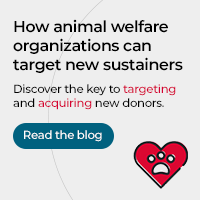Benchmark Findings
Compared to some of their nonprofit peers, animal welfare organizations have experienced a different world since the onset of the COVID-19 pandemic. For the most part, it would appear that "business as usual" could describe it. But that would be akin to admiring a duck gliding across the water without seeing the intense paddling beneath the surface.
The biggest change has been the shift in mindset away from the focus on adoptions and toward the idea of keeping pets in the home. With more people acquiring pets during the pandemic, organizations have recognized this need more and more.
At the same time, animal welfare organizations are modernizing their approach to fundraising. The shift in mindset requires fresh thinking in messaging and creative. Animal welfare organizations are also investing heavily in digital marketing, sustainer growth and building a stronger pipeline to major donors.
This context is essential to understanding the story behind the numbers of our 2023 Animal Welfare Benchmark Report. In the data, you'll see the following key learnings:
1. Post-COVID animal welfare organizations are stronger today.
The dynamics of social change surrounding the pandemic did not have a major impact on the fundraising results of animal welfare organizations. While nonprofits in human services experienced dramatic spikes and subsequent regressions, animal welfare organizations grew steadily each year through 2022.
2. 2020 and 2021 represent gentle positive trends.
Animal welfare organizations showed an upward trend in fundraising revenue during the peak of COVID, and that revenue growth continued after the emergency of the pandemic subsided in 2022. Growth was driven by increases in both the size of donor files and average donor value.
3. Midwest showed strongest revenue growth. Performance trends were similar across org size.
The Midwest outperformed other regions in terms of revenue growth, which was fueled by jumps in average gift and gift frequency in 2022 versus 2018. The Northeast retained and gained the highest number of donors. In terms of organization size, we observed similar themes of growth and donor loyalty in all metrics.
4. Retention levels should be watched closely.
Retention and reactivation rates of core and transition donors were relatively unchanged from pre-COVID. However, retention of reactivated donors softened to the lowest level observed since 2018.
About the Report
What we measured
The 2023 Animal Welfare Benchmark Report contains full-file data from 88 RKD animal welfare clients across the United States from Jan. 1, 2018, to Dec. 31, 2022. The data includes overall program metrics, like total revenue, active donors, new donors, retention rate, average gift size, donor value and gift frequency.
We’ve broken this data out into five regions across the U.S.: West, Southwest, Midwest, Northeast and Southeast. We’ve also categorized the data by organization size (determined by active donor file size in 2022):
- Large (10,000 or more donors)
- Mid (5,000 to 9,999 donors)
- Small (2,000 to 4,999 donors)
- Emerging (under 2,000 donors)
Trends are based on all donors and all gift types. Donors with a gift of $10,000 or more were excluded.
How to read the benchmarks
Each metric is indexed. We set 2018 as the baseline value of 100. Results in the following years are compared against 2018 and then averaged across clients, explaining the relative change in result for each benchmark over time.
Values over 100 indicate an increase over the value in 2018. Values below 100 indicate a decrease vs. the value in 2018. For example, an active donor value of 200 would represent a doubling in the number of active donors.
Overall Findings
Revenue remains strong
While some worried that animals might be an afterthought during the pandemic, revenue at animal welfare organizations grew year over year from 2018 to 2022. That means revenue is 31% higher today than it was in 2018.
Average gift amounts are up
The average gift across all active donors was 10% higher in 2022 than it was pre-COVID. Both new and existing donors are giving larger amounts on average.
Donors are giving more often
Gift frequency increased 6% from 2019 to 2020 and remained flat in the following two years. In 2022, donors gave 7% more frequently than pre-COVID. As a driver of healthy retention, donors giving larger gifts more often should help strengthen animal welfare organizations for future years.
Average donor value reaches new heights
Donor value in 2022 exceeded pre-COVID levels by 18%. It shouldn’t be a big surprise that having donors give larger gifts more often would result in a better donor value. But animal welfare donors are demonstrating levels of generosity that we’ve typically not seen before.
All lifecycles are up in value
The rise in donor value isn’t isolated to a particular group of donors. These new giving patterns are continuing across all audiences, resulting in value growth across all donor lifecycles.
Retention is softening
Despite high gift amounts and more frequent gifts, retention looks similar to pre-COVID levels. Transition donors saw a positive spike in retention in 2020 and 2021, but that number came back down in 2022. Retention of core donors has remained consistent over the last five years.
Deeply lapsed reactivation falls below historical levels
The reactivation of deeply lapsed donors has continued to decline since 2018 and today sits 34% lower. Recently lapsed donors have seen mixed results, and 2022 was up 9% over pre-COVID levels.
Acquisition Findings
Animal welfare donor files are bigger
The growth in revenue above also came from a growth in donors. Animal welfare organizations today have 15% more donors than they did prior to the pandemic.
Acquisition fueled donor file growth
New donor volumes continue to rise steadily year over year. In 2022, animal welfare organizations saw 15% more new donors compared to 2018.
A new quality of donor emerges
Animal welfare organizations have been acquiring a whole new quality of donor —with a first gift value 6% higher than in 2018. This softened vs. the surge in 2021, but organizations are continuing to fuel their new donor pipelines with a better mix of donor quality and value. For most orgs, this means average gifts of $100 and higher.
Acquiring more at all levels
The “new normal” for acquisition post-COVID looks strong. The expansion of new donor volumes is settling in at quantities that exceed historical pre-COVID benchmarks, especially among the highest value donors. Acquisition at every gift level was up in 2022 vs. 2018.
Regional Benchmarks
We divided the U.S. into five distinct regions to analyze how giving trends look across the country.
Midwest leads the way in 4 of 7 categories
We see similar patterns across regions, but the Midwest has the highest revenue growth, average gift, gift frequency and donor value. The Southeast has the biggest donor file growth, the Northeast brought in the most new donors, and the Southwest had the highest first gift.
Retention and reactivation patterns are similar
The retention and reactivation trends look similar across regions. The Northeast experienced the biggest lift in core donor retention, while the Southwest had the best transition retention. The Southeast had the highest metric among recently lapsed and deeply lapsed donors.
Organization Size Benchmarks
We categorized the data by organization size (determined by active donor file size in 2022) to analyze how giving trends look:
- Large (10,000 or more donors)
- Mid (5,000 to 9,999 donors)
- Small (2,000 to 4,999 donors)
- Emerging (under 2,000 donors)
Patterns are similar across organization size
For the most part, animal welfare organizations of all sizes have similar results. Large organizations have shown the fewest fluctuations year over year.
Mid-sized organizations saw the biggest lift during COVID
In both core and transition donor retention, mid-sized organizations led the way in 2020 and 2021. Retention numbers softened in 2022 for all sizes but emerging organizations. Mid-sized organizations also have the best recently lapsed metric—12% higher than pre-COVID.
About RKD Group
RKD Group is a leading fundraising and marketing services provider to hundreds of nonprofit organizations. With five decades of experience, RKD Group's omnichannel approach leverages technology, advanced data science and award-winning strategic and creative leadership to accelerate net revenue growth, build long-term donor relationships and drive the best return on investment. RKD Group creates breakthroughs never thought possible.
![Mollison10xPillarPageTemplate.png [This image is under extended electronic license for template purposes only. Please replace with your own image before publishing your page.] Mollison10xPillarPageTemplate.png [This image is under extended electronic license for template purposes only. Please replace with your own image before publishing your page.]](Marketplace/3P_Creative_Group/Mollison_Pillar_Page_Template/Images/Mollison10xPillarPageTemplate.png)

-1.png?width=150&height=75&name=RKD-logo-red-tm%20(1)-1.png)


